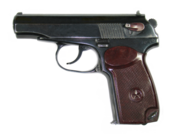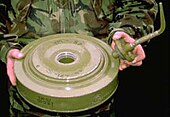List of military equipment used by UMkhonto we Sizwe
In the early years of its armed resistance campaign, the African National Congress and its armed wing, uMkhonto we Sizwe (MK), used whatever arms and war materiel it could lay its hands on. ANC members in exile became adept at building home-made explosives, including time bombs, from materials the movement could acquire from commercial sources.[1] According to Nelson Mandela, as early as 1953 the ANC began sending delegations abroad to petition sympathetic governments for military aid.[2] From the early 1960s, the ANC became more influenced by the South African Communist Party (SACP), which enjoyed close political ties to the Soviet Union.[2] Following the SACP and ANC's formation of MK in 1961, SACP members such as Arthur Goldreich made several tours of the Soviet Union and Warsaw Pact member states to solicit military aid.[2] Beginning in 1963, the Soviet Union became the largest contributor of war materiel and arms to MK. It supplied an estimated 36 million rubles' worth of military equipment to MK from 1963 to 1990, including pistols, rifles, machine guns, grenade launchers, and ammunition.[3] By 1982 an estimated 90% of MK's equipment was of Soviet origin.[4] The remainder came from other Warsaw Pact member states or sympathetic revolutionary movements; for example, MK received ex-Portuguese Uzi and Sterling submachine guns from the People's Armed Forces of Liberation of Angola (FAPLA) during the mid-1970s.[5] The People's Liberation Army of Namibia (PLAN) also donated some arms and ammunition to MK.[5] MK used these weapons during its economic sabotage activities inside South Africa, as well as in semi-conventional military operations in Angola and elsewhere.[6]
MK cadres were frequently sent to the Soviet Union, and to a lesser extent East Germany, to receive military training on these weapons abroad.[4] However, the Soviet Union, East Germany, and Cuba also sent military instructors to help train MK cadres in friendly African nations where the ANC operated in exile, such as Angola, Tanzania, Uganda, and Ethiopia.[4][7] MK stored most of its equipment in large arms depots located in neighbouring states around South Africa, and operated various smuggling routes to bring this materiel to its domestic insurgent cells.[8] The materiel was smuggled across the border in small quantities and then mostly cached in major urban centers where the ANC had a large and active political following.[9]
Although the MK was never able to achieve parity in conventional weapons with the South African security forces, by the early 1990s it had stockpiled enough small arms inside the country to mount a determined guerrilla campaign indefinitely.[10] The small arms most commonly carried by MK insurgents included TT-33 and Makarov pistols, Škorpion vz. 61 submachine guns, and Kalashnikov-pattern assault rifles.[11][12] The pistols and Škorpions were always issued in much larger numbers to MK recruits than rifles, as they were considered more suitable for hit-and-run attacks and assassinations, and discouraged prolonged firefights in which the insurgents would always be at a disadvantage.[13] During the final years of its struggle, MK complemented these weapons with Stechkin automatic pistols.[14] In its early operations, MK also favoured the Uzi submachine gun, a number of which were recovered from its arms caches during the late 1960s.[15] It was later superseded by the Škorpion, although MK recruits continued to be trained on the Uzi as late as 1977.[16] The MK leadership consistently displayed a preference for compact, easily concealable weapons with more firepower than semi-automatic pistols but less cumbersome than full-sized rifles.[14]
MK amassed one of southern Africa's largest stockpiles of land mines held by a non-state entity, consisting of over 19,000 anti-tank mines, 13,000 anti-personnel mines, and 5,000 limpet mines.[17] An air defence regiment was formed in the late 1970s under the guidance of Cuban instructors.[18] This unit was to provide security for external MK base camps that might be targeted by South African air raids, and was equipped with ZPU-1 anti-aircraft guns and Strela-2 (SA-7) surface-to-air missiles.[18]
After the end of apartheid, MK surrendered oversight of its depots and equipment to the newly constituted South African National Defence Force (SANDF).[8]
Small arms
[edit]| Model | Image | Origin | Type | Calibre | Notes | ||
|---|---|---|---|---|---|---|---|
| Pistols | |||||||
| TT-33[12] | 
|
Pistol | 7.62x25mm | ||||
| Makarov PM[1] | 
|
Pistol | 9x18mm | ||||
| Stechkin APS[19] | 
|
Machine pistol | 9x18mm | ||||
| Submachine guns | |||||||
| PPSH-41 | 
|
Submachine gun | 7.62x25mm | Recovered from MK caches in Mozambique.[20] | |||
| Sa vz. 25[21] | 
|
Submachine gun | 9x19mm | ||||
| Škorpion Vz. 61 | 
|
Submachine gun | .32 ACP | Possibly up to 2,000 delivered by Czechoslovakia.[22] | |||
| Sterling[5] | 
|
Submachine gun | 9x19mm | ||||
| Uzi | 
|
Submachine gun | 9x19mm | Recovered from MK arms caches in Rhodesia.[15] | |||
| Rifles | |||||||
| SKS | Semi-automatic rifle | 7.62x39mm | 3,362 delivered by the Soviet Union.[23] | ||||
| AK-47 | 
|
Assault rifle | 7.62x39mm | "Several thousand" delivered by the Soviet Union.[23] | |||
| AKM | 
|
Assault rifle | 7.62x39mm | Issued to some MK cadres by the late 1980s.[24][19] | |||
| PM md. 63 | 
|
Assault rifle | 7.62x39mm | Recovered from MK arms caches in Mozambique.[20] | |||
| Dragunov SVD[25] | 
|
Precision rifle | 7.62×54mmR | ||||
| Machine guns | |||||||
| RPD | 
|
Light machine gun | 7.62x39mm | Recovered from MK caches in Mozambique.[20] | |||
| RPK | 
|
Light machine gun | 7.62x39mm | Recovered from MK caches in Mozambique.[20] | |||
| RP-46[25] | 
|
Light machine gun | 7.62×54mmR | ||||
| PK | 
|
Medium machine gun | 7.62×54mmR | Recovered from MK caches in Mozambique.[20] | |||
| Portable anti-tank weapons | |||||||
| RPG-7[26] | 
|
Rocket-propelled grenade | 85mm | ||||
| 9M14 Malyutka | 
|
Anti-tank guided missile | 125mm | 20 delivered by the Soviet Union.[23] | |||
Grenades and explosives
[edit]| Model | Image | Origin | Type | Notes |
|---|---|---|---|---|
| F1[19] | 
|
Hand grenade | ||
| RG-42[27] | 
|
Hand grenade | ||
| RGD-5[28] | 
|
Hand grenade | ||
| TM-57 | 
|
Anti-tank mine | Some recovered from an MK cache in Umgababa in 1985.[21] | |
| MPM/Type 158[19] | Limpet mine |
Light artillery and air defence
[edit]| Model | Image | Origin | Type | Calibre | Notes | ||
|---|---|---|---|---|---|---|---|
| Artillery | |||||||
| 9P132 Grad-P | 
|
Rocket launcher | 122mm | 90 delivered by the Soviet Union.[23] | |||
| B-10[16] | 
|
Recoilless rifle | 82mm | Used to guard external training camps.[29] | |||
| B-11[25] | 
|
Recoilless rifle | 107mm | ||||
| ZPU-1[18] | 
|
Anti-aircraft gun | 14.5mm | ||||
| 9K32 Strela-2 | 
|
Man-portable surface-to-air missile | 72mm | Over 40 delivered by the Soviet Union.[23] | |||
Footnotes
[edit]- ^ a b Magubane & Houston 2004, p. 472.
- ^ a b c Taylor 2006, p. 129.
- ^ Shubin 2008a, p. 249.
- ^ a b c Kolasa 2016, p. 56.
- ^ a b c Shubin 2008b, p. 149.
- ^ Kolasa 2016, p. 57.
- ^ CIA 1986, p. 33.
- ^ a b Douek 2020, p. 268.
- ^ Douek 2020, p. 106.
- ^ Douek 2020, p. 51.
- ^ Aldrich 1988, p. 2.
- ^ a b Rubenzer 2007, p. 702.
- ^ Davis 1987, p. 71.
- ^ a b Shubin 2008b, p. 275.
- ^ a b Wood 2012, p. 30-36.
- ^ a b Bosigo 1982, p. 486.
- ^ HRW 1999.
- ^ a b c Crook 2017, p. 13.
- ^ a b c d Stiff 2001, p. 431.
- ^ a b c d e Moorcraft 1981, p. 111.
- ^ a b TRC 2000a.
- ^ Lodge 2021, p. 403.
- ^ a b c d e Shubin 2008a, p. 250.
- ^ Douek 2020, p. 165.
- ^ a b c CIA 1986, p. 32.
- ^ Magubane & Houston 2004, p. 473.
- ^ Davis 1987, p. 70.
- ^ TRC 2000b.
- ^ Steyn & Söderlund 2014, p. 413.
References
[edit]Online sources
- Aldrich, J.S (28 June 1988). "Letter dated 24 June 1988 from the charge d'affaires A.I. of the Permanent Mission of South Africa to the United Nations addressed to the Secretary-General" (PDF). New York: United Nations. Archived from the original (PDF) on 14 December 2023. Retrieved 25 May 2024.
- CIA, (various) (31 July 1986). "The African National Congress of South Africa: Organization, Communist Ties, and Short-Term Prospects" (PDF). Langley: Central Intelligence Agency. Archived from the original (PDF) on 31 January 2024. Retrieved 25 May 2024.
- Crook, Lionel (March 2017). "South African Gunner" (PDF). Irene (South Africa): South African Gunners' Association. Archived from the original (PDF) on 14 April 2023. Retrieved 25 May 2024.
- HRW, (various) (1999). "Africa Signatories". New York City: Human Rights Watch. Archived from the original on 20 August 2023. Retrieved 25 May 2024.
- TRC, (various) (5 September 2000a). "AUDWAY QONDA MSOMI". Pretoria: Department of Justice and Constitutional Development. Archived from the original on 23 February 2017. Retrieved 25 May 2024.
- TRC, (various) (2000b). "SANDILE GERALD SIZANI". Pretoria: Department of Justice and Constitutional Development. Archived from the original on 7 March 2019. Retrieved 25 May 2024.
Bibliography
- Bosigo, Jeffrey Motutuzele (1982). The Role of the Soviet Union, Cuba, and East Germany in Fomenting Terrorism in Southern Africa: Hearings Before the Subcommittee on Security and Terrorism of the Committee on the Judiciary, United States Senate, Ninety-seventh Congress, Second Session (Report). Washington D.C.: Government Printing Office. Retrieved 25 May 2024.
- Davis, Stephen (1987). Apartheid's Rebels: Inside South Africa's Hidden War. Binghampton, New York: Vail-Ballou Press. ISBN 0-300-03992-1.
- Douek, Daniel (2020). Insurgency and Counterinsurgency in South Africa. London: Hurst & Company. ISBN 978-1849048804.
- Kolasa, Thomas Stanley (11 January 2016). The South African Communist Party: Adapting to Thrive in a Post-Communist Age. Jefferson: McFarland & Company. ISBN 978-0786478040.
- Lodge, Tom (2021). Red Road to Freedom: A History of the South African Communist Party, 1921-2021. Suffolk: Boydell & Brewer. ISBN 978-1847013217.
- Magubane, Bernard; Houston, Gregory (2004). The Road to Democracy in South Africa. Vol. 2. Johannesburg: Zebra Press. ISBN 978-1868884063.
- Moorcraft, Paul (1 January 1981). Africa's Super Power. Johannesburg: Sygma Books & Collins Vaal. ISBN 978-0868760094.
- Rubenzer, Trevor (2007). Heo, Uk; DeRouen, Karl (eds.). Civil Wars of the World: Major Conflicts Since World War II. Vol. 1. Santa Barbara: ABC-CLIO. ISBN 978-1851099207.
- Steyn, Douw; Söderlund, Arnè (2014). Iron Fist From The Sea: South Africa's Seaborne Raiders 1978-1988. Solihull: Helion & Company. ISBN 978-1909982284.
- Shubin, Vladimir Gennadyevich (2008a). The Hot "Cold War": The USSR in Southern Africa. London: Pluto Press. ISBN 978-0-7453-2472-2.
- Shubin, Vladimir Gennadyevich (2008b). ANC: A View from Moscow. Johannesburg: Jacana Media. ISBN 978-1770096318.
- Stiff, Peter (2001). Warfare by Other Means: South Africa in the 1980s and 1990s. Alberton (South Africa): Galago Publishing. ISBN 978-1919854014.
- Taylor, Ian (27 September 2006). China and Africa: Engagement and Compromise. Abingdon: Routledge. ISBN 978-0415397407.
- Wood, Richard (2012). Zambezi Valley Insurgency: Early Rhodesian Bush War Operations. Solihull: Helion & Company. ISBN 978-1907677625.
